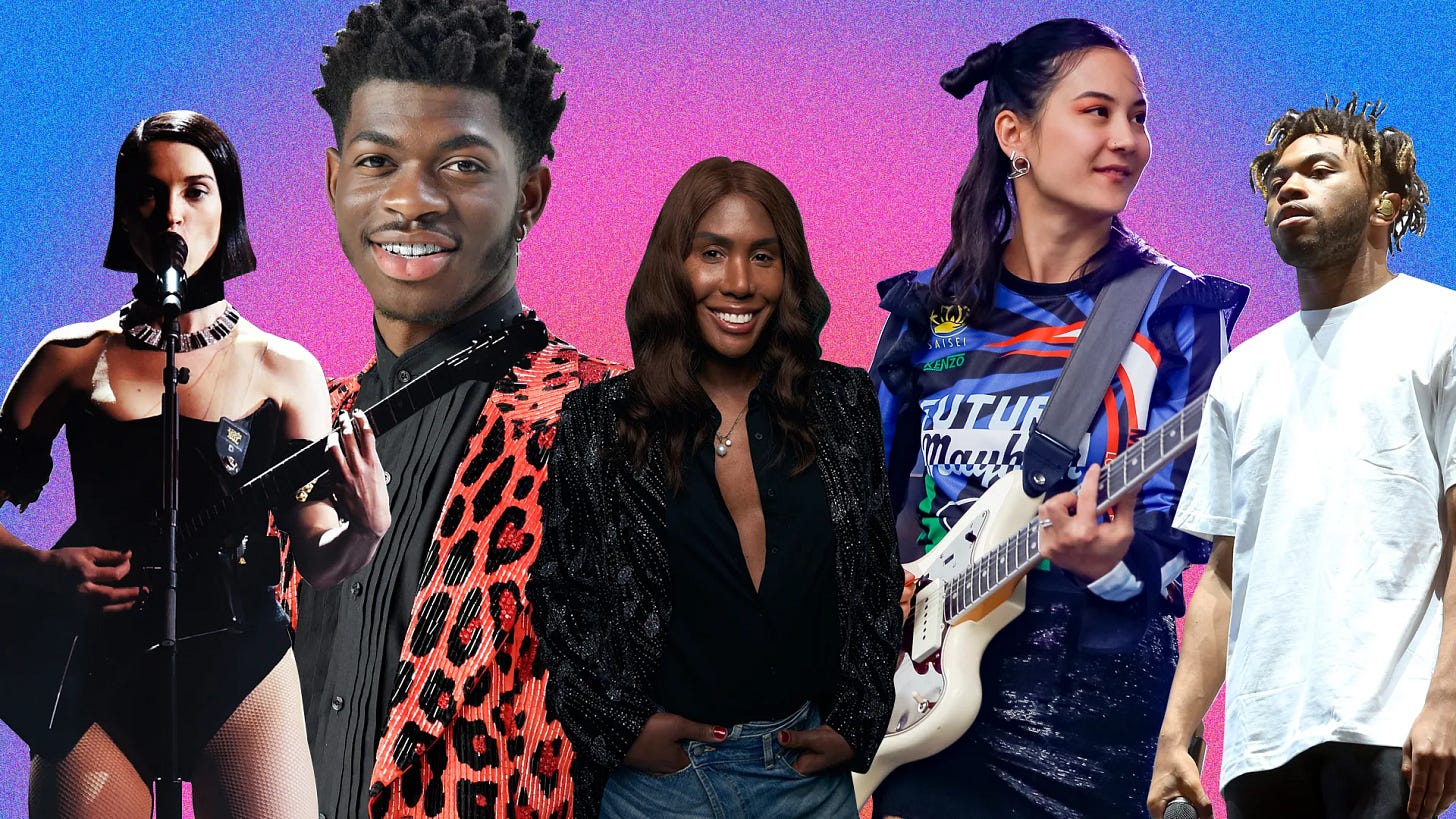🧠✨The Nexialist #0008
Pillar Point | LGBTQ+ Albums | Polygendered Brazilian Music | We All Want to Be Young | Tropicália | Music Internationalization | Internet Beats | From Pop Puppet to Indie Icon
Welcome to The Nexialist, the newsletter that might make you a bit confused sometimes but you like that.
Since this weekend, Amsterdam has seen its best weather in months, and I can’t stop feeling that I have survived winter 2020-21. It’s a great feeling. So, if you allow me, this edition will be a bit more musical and cheerful. I was debating with myself if this would be “enough.” My argument that it is enough: music can tell so much about us, as individuals and societies. Songs, artists, platforms… they all function in a context that allows good observers to learn about each other and with one another, to connect. So grab your coffee and get ready for some musical love.
🕶Mentally, I’m here
You know, this video lives rent-free in my mind. This week I went for a walk every day under the sun and felt exactly like that, especially in the market with the fruits and veggies. After watching it tens of times since it came out, I got curious to know who this woman is, and to my surprise, she’s the mother from the House of LaBeija: Kia LaBeija.
At a time when a wider embrace of representation and identity drives the cultural dialogue, it’s perhaps not surprising that the ballroom icon Kia LaBeija, the 28-year-old current mother of the House of LaBeija and an emerging photographer, has made voguing central to her work as an artist. (For the uninitiated, performers compete under the banner of family-like groups of like-minded individuals, called houses, that are overseen by a de facto parent. The House of LaBeija, founded in 1972, was the first of its kind.)
Read: Kia LaBeija Is Remodeling One of Ballroom’s Legendary Houses For the Future
🏳️🌈LGBTQ+ Albums in 2021
Going on the road, this week I came across this post with 16 Albums LGBTQ+ Artists Are Teasing in 2021. It’s great to see artists that I love there (Romy from The xx, Octo Octa, and Honey Dijon) along with some new faces. Gimme more of that!
📝By the way, Them is a great resource for LGBTQ+ culture.
🇧🇷Polygendered Brazilian Music
Ponto Eletronico released this piece in 2016 called Polygendered Brazilian Music: The Tombamento Generation, written by Filipe Techera.
When analyzing contemporary artistic expression, especially Brazilian music, it is undeniable that there is a link between the artists. The Tombamento Generation, is taking the spotlight; a new wave of singers whose work is united by the representative force of society’s key issues – race, gender, and sexuality. The concept arose from the Black Movement and describes new artistic expressions that operate as a way of fighting and protesting.
Although there is debate as to whether their position is political or aesthetic - or both - this group of artists and their audience together strive to break down the standards of common sense.
Looking back now, I see how much the movement has influenced and grown into the mainstream. I also have been realizing it is a global movement, with its different local twists, and that makes me so proud. In the post, you’ll get to know some artists from that period, so I introduced you to Urias above, to update the list a bit. I love her fierce attitude, the lyrics, the video and is it only me who’s hypnotized?
👨🏻We All Want to Be Young
Ponto Eletronico is part of Box1824, a well-known behavior/consumer research agency from Brazil. On top of their consultancy services, they produce beautiful content about emerging trends. I’ll leave here a TEN-YEAR-OLD VIDEO* that I loved when studying. It explains quite easily what the millennials are about, comparing us to the previous generations. But it’s actually a video about youth culture and how it had evolved up until that point. It’s quite fascinating to watch it now and see how much has changed already.
*I’m learning with the Nexialist that I can share old content, even if my forecasting mind still shames me for it sometimes. Especially when it’s content that deserves looking back to help us look forward.
🦜Tropicalia
Talking about youth culture, Tropicalia was exactly that back in the late 60s and early 70s in militarized Brazil. Thankfully, Pitchfork made this post with a short 6min video explaining the movement, with a list of 20 albums. Iconic artists like Caetano Veloso, Gal Costa, Gilberto Gil e Rita Lee are there, so you can thank me later for this education.
Tropicália was a revolution, a movement of subversion and beauty that swept Brazil in the late 1960s. It was a vivid, multi-disciplinary blossom, ranging from poetry to films, theater to visual art. But it was the scene’s bold and adventurous take on música popular brasileira (Brazilian pop music) that made the most noise around the world.
🗺Music Internacionalization
Read: English-Speaking Artists Are Losing Their Global Pop Dominance (RollingStone, 2019)
Since 2015, with the help from the internet (especially Youtube), there has been a big shift in which language music is consumed. In 2015, all top 10 hits on Youtube were in English. Cut to 2018 and eight out of 10 were in Spanish. There was the tipping point of Despacito in the middle. Meanwhile, K-Pop has also gone mainstream.
Now we can produce music on our laptops from anywhere in the world, and listen from any place at any time. Because of this movement, I think the music industry has transformed in the past years. The way music is written (sometimes bi or trilingual), produced, collaborated, and distributed is so different from 10 years ago.
”Music itself is going to become like running water or electricity” - David Bowie, in 2002
Again, artists predicting technological advancements better than anything else.
Above I’m sharing the beautiful video of Rosalía and Bad Bunny, from Spain and Puerco Rico respectively. Both of their latest albums are incredible.
💻Internet Beats
Now that we’re able to get musical references from so many places and times, the musical production possibilities are endless. Music is becoming multi-referenced, non-linear, and fragmented. This Vox video shows how Mura Masa does exactly that.
🥰This Woman
I knew Robyn before, but after watching this video I feel I understand her artistry and a lot of the music industry. Also, after watching it, I got to see her live and cry when THAT song came up. SPOILER ALERT about the video: Basically, the US record labels saw Robyn’s great success and wanted their own Robyn, who we now know is Britney Spears. They even imported her producers.
🤯Since we’re talking about her, I’ll also leave here the fan theory that imagines that "Call Your Girlfriend" and “Dancing on my own” are actually stories told on the same night. Always makes me think of her ingenuity.
😭This Breakup
With the super sad announcement that Daft Punk is ending their activities, I thought of bringing their iconic video album. Someone was kind enough to put them in order on Youtube so you can enjoy them.
❤️If anything made your brain tingle, click like and don't hesitate to share it with the world. It helps The Nexialist to reach more curious minds. See you next week!🦦
🫀If you enjoyed this newsletter, please share it with your friends. If someone amazing sent it to you, tell them you love them, and you can subscribe at thenexialist.substack.com. If you want to know what a Nexialist is, click here. If you want to introduce yourself or give me any feedback, I would love to hear from you. Drop me an e-mail or say hi on LinkedIn or Instagram.








